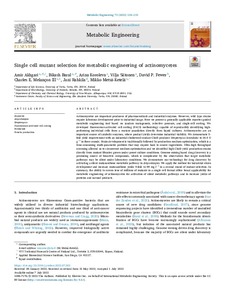Single cell mutant selection for metabolic engineering of actinomycetes
Akhgari Amir.; Baral Bikash; Koroleva Arina; Siitonen Vilja; Fewer David P.; Melançon Charles E.; Rahkila Jani; Metsä-Ketelä Mikko
https://urn.fi/URN:NBN:fi-fe2022091258601
Tiivistelmä
Actinomycetes are important producers of pharmaceuticals and industrial enzymes. However, wild type strains require laborious development prior to industrial usage. Here we present a generally applicable reporter-guided metabolic engineering tool based on random mutagenesis, selective pressure, and single-cell sorting. We developed fluorescence-activated cell sorting (FACS) methodology capable of reproducibly identifying high-performing individual cells from a mutant population directly from liquid cultures. Actinomycetes are an important source of catabolic enzymes, where product yields determine industrial viability. We demonstrate 5-fold yield improvement with an industrial cholesterol oxidase ChoD producer Streptomyces lavendulae to 20.4 U g−1 in three rounds. Strain development is traditionally followed by production medium optimization, which is a time-consuming multi-parameter problem that may require hard to source ingredients. Ultra-high throughput screening allowed us to circumvent medium optimization and we identified high ChoD yield production strains directly from mutant libraries grown under preset culture conditions. Genome-mining based drug discovery is a promising source of bioactive compounds, which is complicated by the observation that target metabolic pathways may be silent under laboratory conditions. We demonstrate our technology for drug discovery by activating a silent mutaxanthene metabolic pathway in Amycolatopsis. We apply the method for industrial strain development and increase mutaxanthene yields 9-fold to 99 mg l−1 in a second round of mutant selection. In summary, the ability to screen tens of millions of mutants in a single cell format offers broad applicability for metabolic engineering of actinomycetes for activation of silent metabolic pathways and to increase yields of proteins and natural products.
Kokoelmat
- Rinnakkaistallenteet [27094]
